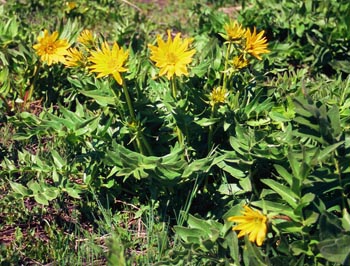Cutleaf Balsamroot

Common Name(s):
Cutleaf balsamroot
Large-leaved Balsamroot
Hairy Balsamroot
Scientific Name:
Balsamorhiza macrophylla Nutt.
Scientific Name Synonyms:
None Known
Symbol:
BAMA4
Description:
Life Span: Perennial
Origin: Native
Season: season goes here
Growth Characteristics: The balsamroots are often among the earliest plants to produce leaves and flowers in spring. Cutleaf balsamroot grows up to 2 feet tall, and begins flowering in mid-April and flowers through early summer. It reproduces from seed.
Flowers: Balsamroots are known for their large, yellow, and sunflower-like, mostly solitary flowers found at the end of a leafless stem. Flowers can be up to 5 inches across, with the yellow ray flowers measuring 1 ½ inches long.
Fruits/Seeds: Fruit is an achene.
Leaves: Cutleaf balsamroot has basal leaves that are 15-30 inches long and pinnately divided into entire-margined or coarsely toothed segments. They are softly pubescent and have a slightly unpleasant medical odor.
Stems: Stems are erect, ascending, and leafless. The stems have long, tangled hairs.
Roots: A thickened, woody taproot which has a pleasant (balsam) odor.
Ecological Adaptions:
Balsamroots are often found in habitat’s consisting of open slopes and barren plateaus. Cutleaf balsamroot is found in rocky meadows, sagebrush scrublands and conifer forests. It is usually found at elevations from 4500 to 7000 feet. It is strongly drought resistant, has good winter-hardiness, tolerates semi-shade, and is strongly tolerant of grazing and trampling.
Soils: Most abundant on well-drained soils, but found on gravelly to clayey soils.
Associated Species: Big sagebrush, bluebunch wheatgrass, cheatgrass, lupine, death camas, and penstemon.
Uses and Management:
Cutleaf balsamroot provides good forage for sheep and big game, and fair for cattle. The flowers are especially palatable, but all portions of the plant except the coarser stalks are eaten. Horses are especially fond of the flowers. The plants are eaten throughout the grazing season but are usually much more palatable during the spring and early summer than later when they become tough and dry.
Balsamroots will increase when grazed by cattle, but decrease when grazed by sheep or deer on winter ranges.
Cheyenne Indians boiled roots, stems, and leaves, and drank the decoction for stomach pains and headaches; they also steamed the plant and inhaled the vapors for the same purposes. Ripe seeds were pounded into flour. The fleshy, edible roots were often eaten raw or boiled.

